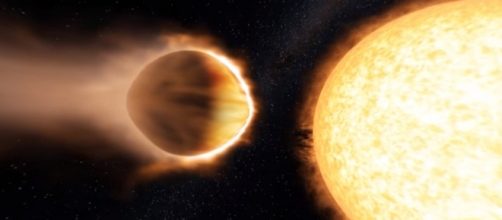For a while astronomers, have been able to spot exoplanets outside of our solar system. Now, for the first time ever an Exomoon has been detected by the Kepler Space Telescope. Also, a strange exoplanet with a "glowing water vapor stratosphere" has been discovered.
How was the exomoon discovered?
A team of researchers led by Columbia Univerity's David Kipling used data from the Kepler Space Telescope while viewing the star Kepler-1625 to discover the exomoon. When examining the star, they spotted a regular dip in the light levels it emits, indicating an exoplanet.
However, they realized that when this exoplanet passed in front of Kepler-1625 the brightness of the light behind it dipped even more, suggesting that an exomoon was orbiting the planet. Based on the data, which only has about a 1 in 16,000 chance of being incorrect, the exomoon is very big. The planet it is orbiting is about the same size as Jupiter, with the exomoon being as large as Neptune is. That makes this exomoon roughly four times the size of Earth.
A 'glowing water vapor' atmosphere
A team of scientists has discovered yet another strange exoplanet, WASP-121b, with their findings being published in the scientific journal “Nature.” This planet is yet another Hot Jupiter-type exoplanet, with a larger mass and radius than Jupiter itself.
Using the Hubble and Spitzer space telescopes, the team looked for evidence of an atmosphere, but instead found that WASP-121b, located 880 light-years away from Earth, had a stratosphere.
This recent discovery gives astronomers the strongest evidence so far that Hot Jupiter-like planets have stratospheres. However, the stratosphere of WASP-121b is made up of water vapor that's such a high temperature that it glows. The stratosphere is the layer of the atmosphere where temperatures increase at higher altitudes.
In Earth's stratosphere, this means that the ozone layer captures harmful ultraviolet radiation from the Sun, which warms it. Jupiter's stratosphere is warmed by methane gas trapped in it.
The scientific team studying the planet used Hubble to analyze the exoplanet's brightness and how it changed at different wavelengths of light. Using the telescope, scientists compared WASP-121b's water molecules to fireworks, with the source of their colors being chemicals that emit light. They also give off radiation in the form of infrared light.


